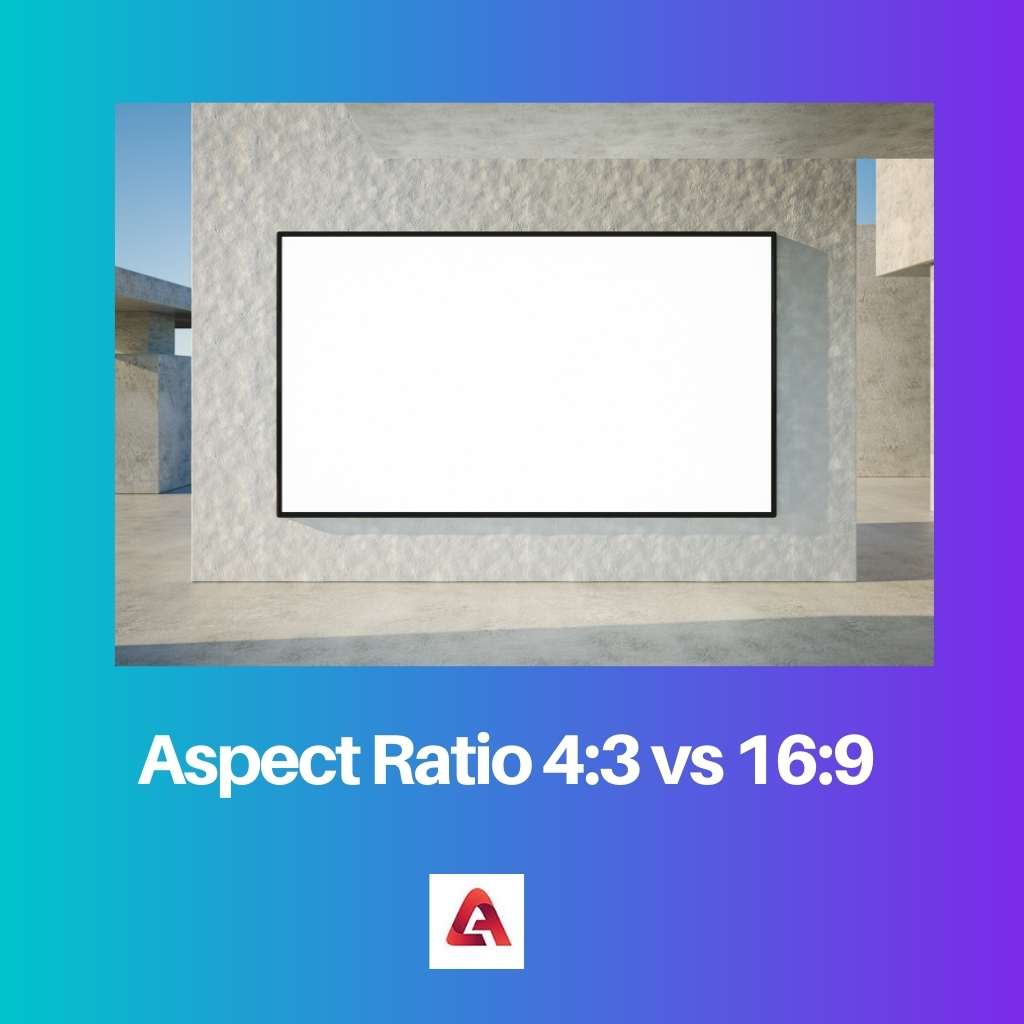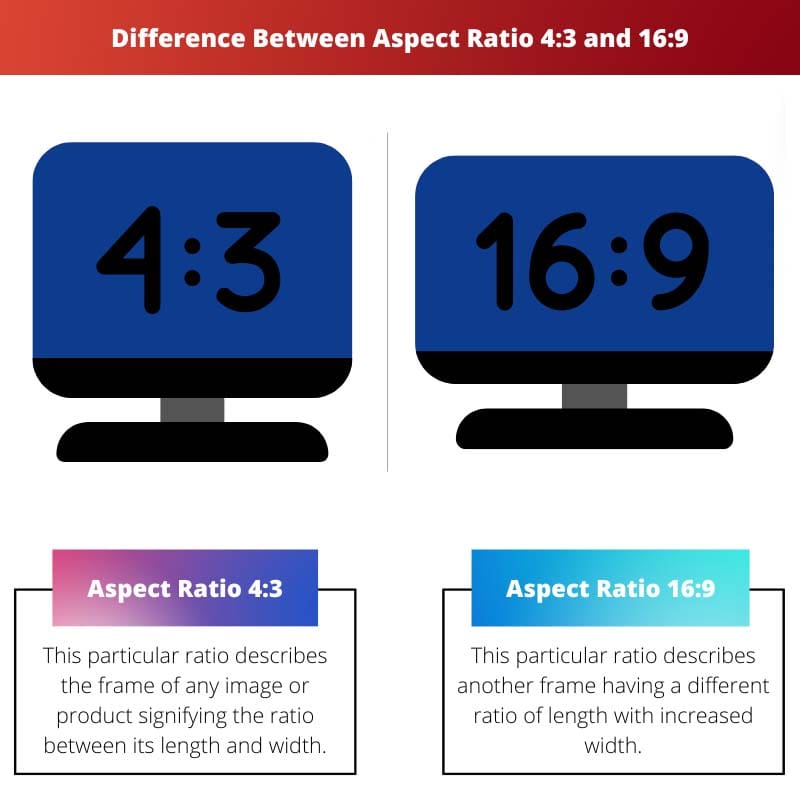Images have become a work of art these days, and it has become significantly important to ascertain what kind of dimensions a particular person wants for his images or videos or even in other specific things like a television etc.
A particular phenomenon that decides the dimensions of anything is known as aspect ratio, and two very popular aspect ratios are Aspect Ratio 4:3 and 16:9, which can be hard to differentiate.
Key Takeaways
- A 4:3 aspect ratio is more square-shaped and was the standard for older television and computer monitors.
- A 16:9 aspect ratio is widescreen, the current standard for televisions, computer monitors, and smartphones.
- Widescreen aspect ratios, like 16:9, offer better viewing experiences for movies and modern video content than 4:3.
Aspect Ratio 4:3 vs 16:9
The aspect ratio 4:3, also known as “standard definition,” is a screen dimension that is more square-shaped, commonly used in older television sets and computer monitors. The aspect ratio 16:9, also known as “widescreen,” is more rectangular and is the standard for HDTV and Full HD video formats.

Aspect Ratio 4:3 is a term signifying a particular frame that creates a width where the wider size of the frame happens to be approximately 33% wider as compared to the narrower side.
This particular aspect is used for specified purposes and is very popular and common all across the globe for multiple subsiding reasons.
While on the other hand, Aspect Ratio 16:9 is a term that signifies a particular frame in which the wider size happens to be approximately 78% wider as compared to the narrower side, and the frame created is recorded in a separate diagonal view as that of aspect ratio 4:3.
This particular ratio is becoming very popular in high-definition televisions and other products.
Comparison Table
| Parameters of Comparison | Aspect Ratio 4:3 | Aspect Ratio 16:9 |
|---|---|---|
| Meaning | This particular ratio describes the frame of any image or product signifying the ratio between its length and width. | This particular ratio describes another frame having a different ratio of length with increased width. |
| Recording of the view | The view in this particular frame is recorded in a more vertical manner | The view in this particular frame is recorded in a more horizontal manner. |
| Also known as | This ratio is also known as the full-screen ratio. | This ratio is popularly known as the widescreen ratio. |
| Increase in the width | The wider part of this particular frame happens to be approximately 33% wide. | The wider part of this particular frame happens to be approximately 78% wide. |
| Most suitable for | This particular ratio is very popular among simple television and computers. | This particular ratio has emerged as a suitable frame for recently manufactured televisions and high-tech computers |
What is Aspect Ratio 4:3?
Popularly known as a full-screen ratio, Aspect Ratio 4:3 is a very popular aspect ratio that has been applicable to many frames all across the globe for the past many years, and as this frame allows the user to capture more information, it has created a unique name for itself in the field of aspect ratios.
In the 1990s, this particular frame became very popular among common people, especially for people who were in the field of production of films.
The reason behind this increased fan following of this aspect ratio was that it was the easiest ratio to be used while releasing any particular film as it needed not to be converted further for any particular use.
This feasibility of this ratio to be used in almost all purposes made it a versatile one in its nature and paved a path for easy mirroring of films.
Since then, this particular ratio has been used not just in films but in televisions as well as computers as well.
A very significant feature of this aspect ratio is that it allows the wider size of the frame to be 33% wide as compared to the narrower side.
Apart from this feature, this aspect ratio allows the user to create the frame in a more vertical manner capturing the utmost details.
What is Aspect Ratio 16:9?
Popularly known as the widescreen ratio, the aspect ratio has created a sensation in the field of wide frames all across the world.
Till the year 2010, this particular frame was considered a luxury for specific purposes, but as the popularity of this frame increased, people started using this particular frame in minimal things like televisions and computers as well.
And slowly and steadily, this particular frame took over all the popular frames that were being used in these televisions and computers over the course of time.
The reason behind this particular frame being called a wide-screen frame is that it allows the wider side of the frame to be 78% wider as compared to the narrower side and eventually, it allows capturing more details.
However, unlike the previous aspect ratio, this particular frame records views in a horizontal manner.
A Very prominent fact about this particular ratio is that it is the only ratio supported by a DVD format among all the aspect ratios available.
However, nowadays, this ratio has become universal in nature and is being used in all televisions and computers.
Main Differences Between Aspect Ratio 4:3 and 16:9
- Aspect Ratio 4:3 signifies a particular ratio of frame recorded in a more vertical manner, while on the other hand, 16:9 signifies a particular ratio of frame recorded in a more horizontal manner.
- Aspect Ratio 4:3 was the first aspect ratio to be used in televisions and computers while on the other hand, 16:9 has recently replaced the previous ratio and has taken over all the recently manufactured computers and televisions.
- Aspect Ratio 4:3 allows the wider side of the frame to be 33% higher than the narrower side, while on the other hand, 16:9 allows the wider side of the frame to be approximately 78% higher than the narrower side.
- Aspect Ratio 4:3 is also known as the full-screen ratio, while on the other hand, 16:9 it is also known as a widescreen ratio.
- Aspect Ratio 4:3 comes in the ratio of 1:33:1, while on the other hand, 16:9 comes in the ratio of 1:77:1.

